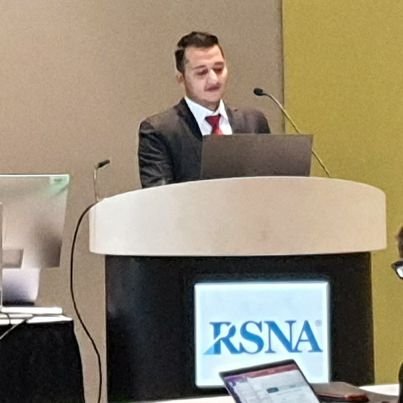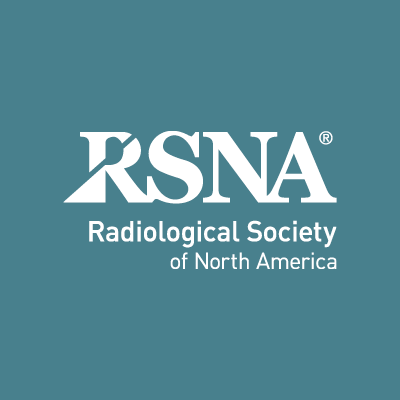
Mohammad Khalafi, MD
@klf_mohammad
Followers
392
Following
4K
Media
39
Statuses
432
Postdoc Researcher @WCMRadiology, Brain Health Imaging Institute (BHII) || Associate Editor (TEB) @Radiology_RSNA
New York, NY
Joined May 2022
Not sure about you, but I’m kinda obsessed with our Ghibli-style version 🤩😎 #NewYork
#Empirestate
0
0
16
#RIAM (Radiology in a Minute)@radiology_rsna Efficacy and Safety of Microwave and Radiofrequency Ablation in the Treatment of Hyperparathyroidism in Older Individuals: A Multicenter Prospective Study Full study link : https://t.co/hFZhFCDUJH
@RITEditor @RadiologyEditor
0
9
13
This @radiology_rsna study shows that MRI based habitat analysis can predict PFS in primary spinal cord tumors! @RadiologyEditor @RITEditor @VChernyakMD Full article: https://t.co/N5zajkBt6V Come find out more with me in this #RIAM:
0
11
18
An incredibly informative interactive QA session on statistics with Dr Schweitzer, EIC of @jmri_ismrm. Many excellent questions were asked and answered! #RadInTraining @radiology_rsna
0
8
23
📢 New in @Radiology_RSNA: Liver MRI–derived proton density fat fraction (PDFF) predicts #diabetes risk in pts with obesity, with a clear dose–response relationship. Deng et al. https://t.co/BnidPS4OBe
@RITEditor @Radiology_Editor @ProfVickyGoh @chemshift1
pubs.rsna.org
The liver MRI–derived proton density fat fraction (PDFF) independently predicted prediabetes and diabetes risk in patients with obesity, and the liver PDFF–dysglycemia relationship was partially me...
1
11
37
🎀 Power up your breast cancer care! Pre-op MRI = lower risk of in-breast recurrence for patients 50 & under, especially for hormone receptor–negative cancers. Knowledge is power, and smarter scans mean stronger outcomes! #Radiology #BreastCancer
https://t.co/9BtbNFbFLy
0
3
2
Can low dose CT (#LDCT) predict #lungcancer risk 🫁 years ahead, even without visible nodules? Answers in new @Radiology_RSNA study! 📖 https://t.co/aHHiRIPHXu
#Tweetorial #RadInTraining @RITEditor @VChernyakMD @RadiologyEditor @chemshift1 @ProfVickyGoh
2
16
32
10/ ✅ Future prospective, multicenter studies needed to validate MRI’s role in young breast cancer patients & refine guidelines. Tailored imaging strategies could improve outcomes! @RITEditor @Radiology_Editor @VChernyakMD @ProfVickyGoh @chemshift1 📄 https://t.co/5rhuacGdz8
pubs.rsna.org
Undergoing preoperative MRI was associated with reduced risk of ipsilateral in-breast recurrence in patients 50 years or younger with breast cancer, with the greatest benefit observed in those with...
0
1
2
9/ ⚠️ MRI debate rages: False positives, costs, & delays spark caution. This study supports selective MRI use in young patients with aggressive, hormone receptor-negative tumors to reduce recurrence risk. #HealthPolicy #RadInTraining
1
0
1
8/ Clinical takeaway: Preoperative MRI may benefit young patients with hormone receptor-negative cancers, cutting in-breast recurrence risk. Selective use could optimize outcomes in this high-risk subgroup. #RadInTraining #BreastHealth
1
0
1
7/ ✅ Strengths: Multicenter design, IPTW balanced confounders. Limits: Retrospective, small no-MRI group (6.7%), low deaths (88) limited survival analysis power (42.6%). Excluded neoadjuvant chemo patients, limiting generalizability! #ResearchMethods #RadInTraining
1
0
1
6/ Hormone receptor-negative cancers (e.g., triple-negative, HER2+) are aggressive, less responsive to hormonal therapy. MRI’s early detection of occult lesions may lower recurrence risk in this high-risk group, especially in young women. #Oncology #RadInTraining
1
0
1
5/ MRI’s edge: Detects 11-14% occult tumors missed by mammography, 0.9-2% missed by mammo + ultrasound. Crucial for young patients with dense breasts, reducing undertreatment risk & recurrence in ipsilateral breast! #RadInTraining #Radiology
1
0
1
4/ In 3680 invasive cancer cases, no survival difference (HR=0.67, p=.38). MRI’s strength lies in reducing recurrence, not mortality, in young patients📉 #BreastCancerResearch #RadInTraining #RSNA #Radiology
1
0
1
3/ Hormone receptor status is key! Pre-op MRI was associated with decreased total recurrence in hormone receptor-negative cancers (8.2% vs 20.7%, sHR=0.40, p=0.04) & in-breast recurrence (sHR=0.28, p=0.01). BUT! No overall survival benefit (HR=0.62,p=.58)! #RadInTraining
1
0
1
2/ Of 4,414 women (mean age 43.2), 93% had preop MRI. 5-yr cumulative incidence of in-breast recurrence: 1.6% (MRI) vs 3.3% (no-MRI). Total recurrence was similar (sHR=0.70, P=.15). MRI group had more advanced cancers pre-adjustment! #RadInTraining
1
0
1
1/ 🚨 #tweetorial Multicenter study in @Radiology_RSNA (4,414 pts, median 7.7-yr follow-up) dives into preoperative MRI’s impact on outcomes for women ≤50 yr with #BreastCancer. MRI linked to lower ipsilateral in-breast recurrence (sHR=0.49, P=.04) #Radiology #RadInTraining
1
8
25
This @radiology_rsna study does a head-to-head comparison between stereotactic radiosurgery and endovascular embolization for treating AVMs involving eloquent brain areas! @RITEditor @VChernyakMD @RadiologyEditor #neurotwitter #Radiology Let’s take a dive deep in this #RIAM:
1
12
19
#RIAM (Radiology in a Minute)@radiology_rsna PSMA PET/CT Reporting: Real-Life Inconsistencies, Heterogeneity, and Underutilization of Scoring Systems and Interpretation Frameworks Full study link : https://t.co/wJjDocAplv
@RITEditor @RadiologyEditor
@VChernyakMD #RadInTraining
0
6
11
🧠Diagnosing #Parkinsons just got smarter! Adding nigrosome 1 or neuromelanin imaging to MRI is a practical, cost-effective way to spot PD & its mimics, and helps pick patients for dopamine transporter scans. More answers, less hassle! #NeuroRad #Radiology
https://t.co/GWdmWJ4W5f
0
2
8
🧵 1/6 🚨 New in @Radiology_RSNA: 7-year Prognostic Value of Coronary CT Angiography-derived Fractional Flow Reserve in Stable Angina https://t.co/oAQHlXjONY
@RITEditor @Radiology_Editor @RSNA
#RadInTraining #CTangiography #CCTA #CardiacImaging
1
14
41









